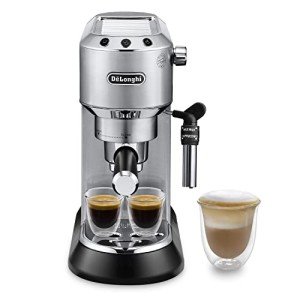The Rise of Home Espresso Machines: A Comprehensive Guide
As coffee enthusiasts continue to seek fresh and delicious brews at home, the appeal of home espresso machines has actually risen over the last few years. No longer simply the domain of coffee shops and coffee bar, these machines empower people to craft barista-quality espresso drinks from the comfort of their kitchen areas. This article will check out the various types of home espresso machines, their features, and factors to consider for selecting the best one. In addition, it will supply a choice of FAQs to help potential purchasers make informed decisions.
Types of Home Espresso Machines
Home espresso machines can be classified into a number of classifications based on their systems and user-friendliness. Each type has its distinct features, pros, and cons.
| Type | Description | Pros | Cons |
|---|---|---|---|
| Manual Espresso Machines | Needs the user to manually control the developing procedure, involving methods like pulling a lever to create pressure. | - Complete control over brewing procedure - Compact design | - Requires ability and practice - Time-consuming |
| Semi-Automatic Machines | Machine automates water circulation and pressure, however the user still manages the dosing and duration of the developing process. | - Balance of automation and control - Versatile | - Learning curve for refining techniques |
| Totally Automatic Machines | Automates the entire brewing procedure, from grinding to developing, often with programmable settings for personalized beverages. | - Extremely easy to use - Quick and hassle-free | - Less control over the developing procedure - Higher cost point |
| Capsule or Pod Machines | Utilizes pre-packaged espresso capsules or pods to develop coffee quickly and easily. | - Extremely easy to use - Minimal cleanup | - Limited taste range - More expensive per cup than ground coffee |
| Super-Automatic Machines | Combines features of totally automatic machines with built-in mills, allowing users to brew whole bean espresso and milk-based drinks with one touch. | - All-in-one benefit - Ideal for milk-based beverages | - Often the most pricey - Can be bulky |
Functions to Consider
When choosing a home espresso machine, potential buyers need to think about the following functions to ensure they select a machine that fulfills their needs:
Grinder Type:
- Built-in grinders can provide fresher premises however might require more upkeep.
- Separate grinders permit more customization of grind size.
Pressure:
- Look for machines that produce at least 9 bars of pressure, which is optimal for developing espresso.
Water Temperature Control:
- Machines with adjustable temperature level settings permit much better extraction of flavor from beans.
Milk Frothing Options:
- Consider whether you want a manual steam wand for frothing or an automatic milk frother for convenience.
Relieve of Cleaning:
- Machines with removable parts and self-cleaning functions considerably minimize cleanup time.
Size and Design:
- Ensure the machine fits easily in your kitchen and lines up with your visual preferences.
Budget:
- Set a budget before starting your search, as prices can range substantially from affordable designs to high-end machines.
Advantages of Home Espresso Machines
Owning a home espresso machine uses various advantages:
- Cost-Effective: Over time, developing espresso at home can save coffee lovers cash compared to regular coffee shop check outs.
- Modification: Users can experiment with different beans, grind sizes, and brewing techniques to discover their best cup.
- Convenience: The capability to brew espresso any time gets rid of the need to head out to a coffee shop, particularly beneficial throughout late nights or mornings.
- Quality assurance: With a home machine, individuals have total control over the quality of ingredients and developing procedures.
Downsides of Home Espresso Machines
Nevertheless, there are some downsides to consider:
- Initial Investment: High-quality espresso machines can be expensive, requiring a substantial in advance financial investment.
- Knowing Curve: Mastering the art of espresso brewing can take time and practice, which may be frightening for beginners.
- Maintenance: Like any home appliance, espresso machines need regular cleaning and upkeep to guarantee ideal efficiency.
Frequently asked questions
1. What is the best kind of home espresso machine for novices?
Answer: For novices, a semi-automatic machine is often advised as it offers a balance in between control and automation, allowing you to discover the fundamentals without frustrating complexity.
2. How much should I invest in a home espresso machine?
Answer: Entry-level machines can begin around ₤ 100 to ₤ 300, while higher-end models can vary from ₤ 500 to over ₤ 2000. It's important to set a budget based upon your anticipated usage and preferred functions.
3. Do I need a different grinder?
Answer: While some espresso machines come with built-in mills, investing in a different grinder enables for greater customization and ensures better quality premises.
4. How often should I clean my espresso machine?
Answer: Cleaning frequency can vary by machine type, but it's generally suggested to clean the machine after each use and perform deep cleansings weekly or regular monthly, depending on use.
5. Can I make milk-based drinks with any espresso machine?
Answer: Not all machines include milk frothing abilities. If you enjoy drinks like lattes or cappuccinos, look for a machine with a steam wand or automatic frother.
Home espresso machines are changing the way coffee connoisseurs enjoy their precious brews. With Automatic Espresso Machines and advanced functions offered in the market, there is something for everyone. Whether it's the delight of creating unique recipes or just appreciating the ideal shot of espresso, buying a home espresso machine can improve both the coffee-drinking experience and the lifestyle for coffee fans everywhere. As with any financial investment, it is important to weigh the benefits versus the possible drawbacks and select a machine that perfectly fits both your way of life and choices.

